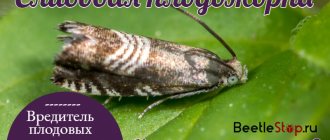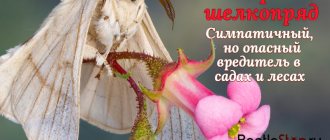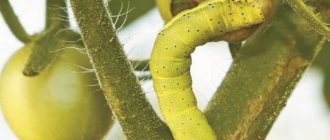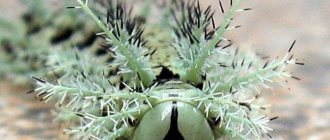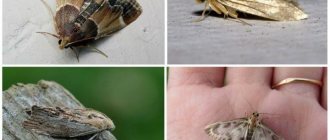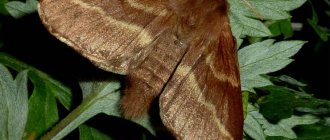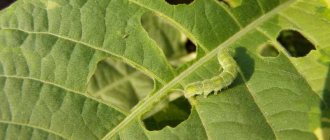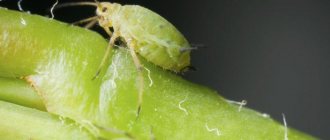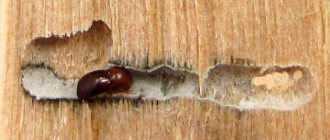Home / Pests and diseases
Back
Published: 06/09/2019
0
Rate this post
Noctuids do not live except at the poles. They can be seen in all climate zones of the Earth, including tundra or deserts. In nature there are about 35 thousand species and varieties. The name is associated with the bird and initially evokes positive emotions. Thus, the white-faced scops owl is a feathered predator; there are also collared scops owls and scops owls - they are of interest to nature lovers. African, North American, Western American - these are also birds! But the insect destroys crops.
All species of this insect are pests for the plant world. So, the cotton bollworm easily settles on tomatoes or corn. An elegant pea plant will not disappear among the weeds. There are types of meadow, grain, alfalfa... The most harmful are the so-called gnawing cutworms.
- 1 General information about cutting armyworms 1.1 Winter armyworm
- 1.2 Garden cutworm
- 1.3 Cabbage scoop
Measures to combat caterpillars
Prevention against caterpillars
- Regularly inspect the beds for the presence of caterpillars, as well as their clutches. Destroy any pests found.
- Attract birds to the site (build feeders and birdhouses for them in early spring), natural enemies of the caterpillars.
- Do not leave plant debris and fallen leaves on the site.
Traditional methods of fighting caterpillars
Plants are sprayed with chamomile infusion: 1 kg of leaves and inflorescences are poured into 10 liters of hot water, then infused for 12 hours. Before use, the composition is diluted with water 1:3.
Mechanical track protection
Non-woven materials have become an effective means of protecting cabbage from many pests: agril, lutrasil, spunbond. Most pests, especially flying ones, cannot get to plants covered with them.
Active measures to combat caterpillars: drugs forgive caterpillars
To protect vegetable crops from caterpillars, the drugs “Bitoxibacillin”, “Lepidotsid”, “Iskra M” are used.
How to get rid of cutworms
Chemical and biological drugs
Fury
Broad-spectrum insecticide. Protects plants for 25 days. Drug concentration: 1.5 ml per 10 liters of water. The maximum number of treatments during the season is no more than 2 times.
Proteus
A new systemic contact insecticide of combined action in the form of an oily dispersion. This allows the active components to quickly act on pests, penetrate inside the leaves, and not be washed off in the rain. The drug is recommended for use in the early stages - during the period of oviposition and the appearance of younger larvae.
7 ml of insecticide is poured into 3–5 liters of water, shake the solution well and spray the plants in dry and windless weather.
Cabbage butterfly
Caterpillar of the cabbage butterfly (cabbage white butterfly) living on white cabbage. It feeds on leaves, which are then full of holes. Moreover, the larvae can move deeper into the head of cabbage and settle there firmly.
cabbage butterfly and its caterpillars
Measures to combat cabbage weeds
You can try spraying the cabbage with an infusion of tomato tops and onion peels.
Insecticides also help: “Aliot”, “Herold”. This is interesting! The most terrible natural enemy of cabbage caterpillars is the wasp. She lays eggs directly into the caterpillars. One female can lay up to 300 eggs in a caterpillar. Soon the eggs hatch into larvae that feed on the juices of the caterpillar, but the caterpillar itself soon dies. Wasps can be attracted to cabbage by spilling it with sweet water, diluted jam or syrup.
What do caterpillars and their larvae eat?
The caterpillar, hatched from the egg, first of all eats its shell, inside which it developed. Most of these creatures are herbivores; they feed on leaves and plant fruits. But there are also predators that eat sedentary insects, scale insects. Unlike butterflies, these insects eat solid food and therefore have strong gnawing jaws. The upper jaw is more powerful; there are teeth with which it chews food.
Insects consume leaves in such a way that it is easy to determine which larvae fed there. Small-sized individuals gnaw only the upper or lower part of the leaf. They leave transparent slits of intact thin skin.
Due to the fact that the hatched larvae immediately begin to feed heavily, the integument, which does not stretch, soon becomes small. The insect is forced to stop feeding for a while and shed its skin. During its life, the caterpillar molts 4-5 times.
Classification of larvae
The digestive tract of these creatures is concentrated at the back and front of the body. This helps you digest food calmly even while moving. Their digestive tract secretes enzymes that help them process food easily. Scientists classify the larvae depending on what the caterpillar eats.
Polyphages - eat plants
These insects are polyphagous, as they consume any plant for food, indiscriminately. These include moths (moth, wine hawk moth, peacock eye). The advantage of polyphages is that they exist with an unstable food supply. Weakness: poor digestion of food.
Oligophagous - eat plants of a certain type
They prefer to eat one type of plant, one family or type, and do not allow mixing. These include the polyxena species, which feeds only on some of the genus Kirkazon, and the Mahayana larvae only on celery. Or the codling moth, which eats apples and plums.
Monophagous - eat a strictly specific type of plant
These are the most selective individuals who prefer to eat one type of plant. An example is the silkworm larva, which eats only mulberries.
Xylophages - eat wood
Wood is the only thing the caterpillar of this species feeds on. Xylophages make up a minority, compared to other species, their number is insignificant. They gnaw tunnels in tree trunks and branches. The roots of herbaceous plants can act as food due to their woody composition.
Swallowtail
The swallowtail caterpillar looks no less bright and attractive than the butterfly itself: green, with black transverse stripes and orange splashes. The pest is very voracious, feeding mainly on Umbelliferae (carrots, parsley, dill, etc.).
Swallowtail butterfly and its caterpillar
Measures to combat swallowtail butterfly caterpillars
Caterpillars are mainly collected by hand: due to their bright color and large size, they are not difficult to find.
Pesticides are a universal remedy
Of course, the list should be headed by the most effective means, which are rightfully considered pesticides, which have an immediate effect and a good reputation. To use any insecticides, it is necessary to strictly follow the instructions, and also take into account what kind of larva we are talking about, because there are preparations with a broad effect, or a more narrow focus. Do not forget that the effectiveness of spraying depends on the timing of this procedure. The most ideal moment will be when the caterpillars hatch from the eggs. This usually occurs 10 days after a heavy invasion of butterflies. If you can successfully choose the time and means, carry out all the procedures with clear instructions, including high-quality spraying, then you can safely count on success and confidence in the protection of the crop and foliage.
Cabbage scoop
The cabbage cutworm, in addition to cabbage itself, can feed on the leaves of potatoes, tomatoes, beets and other garden crops. Often found in areas with high humidity.
Cabbage moth butterfly and its caterpillar
Measures to combat cabbage cutworm
If cabbage is attacked by cutworms, try spraying the plants with infusions of burdock leaves, tomato tops or onion peels. In serious cases, you will have to resort to insecticides: “Herold”, “Senpai”, “Lepidotsid”, “Fitoverm”, etc.
What caterpillars can be found in the garden?
There are many types of caterpillars that can ruin the life of a gardener. The most common species in the garden are hawthorns . Their clutches can usually be found on tree leaves entangled in cobwebs. Neighboring them are goldentails , which settle on small branches, also enveloping them in a “shawl” of cobwebs.
Leaf rollers are extremely dangerous , which, despite their small size, can quickly destroy buds, leaves and flowers. A sign that these particular caterpillars have chosen your site are the leaves of plants twisted into a tube, inside of which there is the same cobweb. Several generations of leaf rollers are born in one season, so it is necessary to combat this pest very quickly. And if you notice a furry caterpillar or a cluster of eggs covered with thin hairs, most likely a gypsy moth . It can easily and quickly capture the entire area, as it moves from place to place along with the wind.
Prevention
To stop or reduce the appearance of harmful caterpillars in the garden and garden, it is recommended to use preventive measures. To do this, summer residents need to collect and destroy all the leaves remaining from the plants in the fall, dig up the soil under fruit crops, in early spring it is important to promptly fertilize the soil with products effective against overwintered insects, and, most importantly, constantly check the plantings for the presence of eggs and larvae.
Every farmer needs to remember that parasitic insects not only harm plants, but also spread a number of diseases to other crops, therefore, to reliably protect the crop, a whole range of measures must be used.
Caterpillars on coniferous trees, how to fight with folk remedies and medications, read more in the article here.
Beneficial and harmful beetles in the garden - photos, descriptions and what to do with them
Adding an article to a new collection
In the struggle for the harvest in your garden plot, besides you, invisibly, but daily, numerous small but very important creatures take part - beneficial and harmful beetles, mites, butterflies, spiders, bedbugs, aphids and others. In a word - a variety of arthropods.
Some should be kicked out of the garden and dealt with in every possible way if we want our plants to feel good, but for others it would be worth creating all the conditions for a favorable existence - they can bring a lot of benefits.
How to figure out who is who and what to do with them? We will help.
Mustard - a caterpillar's nightmare
Mustard is a universal and potent remedy. Dilute 100 grams of dry mustard powder in a small amount of water. After complete dissolution, add the contents to a bucket of water and leave for a day. After 24 hours your concentrate is ready. This is a concentrate, not a ready-mix, as you need to use the same amount of water as concentrate before spraying. For better effect and adhesion, you can add a couple of tablespoons of liquid soap, which ensures that the liquid stays on the plant for a long time.
Review of chemicals
The easiest way to destroy these insects is using purchased products. There are several proven products whose effectiveness has been proven in practice.
To protect yourself, you need to process plants after wearing a respirator and protective gloves. This will protect your skin and respiratory tract. After treating the area, you need to wash well and change clothes. Remains of the product must be destroyed and not stored until the next spraying procedure.
What folk remedies should I use?
If there are not very many caterpillars on the site, they can be driven away or destroyed using proven folk remedies.
Chamomile
A simple and safe remedy for treating bushes can be prepared using regular chamomile. You can buy it at the pharmacy or prepare it yourself. To prepare the solution, a kilogram of chamomile must be diluted in 10 liters of water. After this, the product must be boiled for 5-10 minutes, and then left to infuse for a couple of hours. The resulting infusion must be filtered. Next, it needs to be diluted with clean water in a ratio of 1 to 3. You can use the product to spray plants immediately.
Red elderberry
Both leaves and branches of elderberry can be used to control pests. 200 grams of fresh product must be thoroughly chopped and poured with 10 liters of boiling water. After this, the product must be sent to a dark place for a day. The resulting infusion should be filtered and immediately used to spray trees and bushes.
Henbane black
As with elderberry, you need to use the branches and leaves of the plant to prepare the decoction. But you need to be careful with berries. They can only harm plants. 2 kilograms of raw materials must be crushed and poured with a small amount of water. The container with henbane should be placed on the stove and boiled over low heat for half an hour. After this, it must be removed from the stove and left for half an hour. The resulting product must be filtered and diluted with water. After this, the infusion should be left alone overnight. In the morning the plants can be sprayed.
To make the product work more effectively, you can add a little grated laundry soap to the container with it.
Vinegar
You can also control pests on flowers and vegetables using vinegar. It has a strong aroma that effectively repels unwanted guests. To prepare the solution, 100 grams of vinegar must be diluted in 10 liters of warm water. The product must be mixed well and poured into a spray bottle. It is necessary to spray both the upper and lower parts of the leaves with the resulting liquid. The remaining product can be used to water the soil around the tree trunk.
The product can be used not only in open beds, but also in a greenhouse. It will get rid of caterpillars that live on cabbage and cucumbers. To completely destroy all pests, you need to treat the bushes with the product once every 8-10 days. But it is worth remembering that if a product is used on a regular basis, the caterpillars can get used to it. Therefore, experienced gardeners recommend alternating spraying with vinegar solution and treating plants with other means.
Sagebrush
Wormwood also has a pungent odor. Therefore, solutions are also prepared from it for spraying areas affected by caterpillars. To prepare the product, add a kilogram of finely chopped greens to water and boil. After 15 minutes, the container must be removed from the stove and the mixture dissolved in 10 liters of water. The liquid should be poured into a spray bottle and immediately used to treat the bushes.
Red pepper
A decoction with red pepper also has an effective effect on pests. To prepare it, 100 grams of vegetables must be cut into large pieces and placed in a pan with 2 liters of water. The product must be boiled for an hour, and then left to infuse for a day. You can use the decoction for spraying immediately.
Before the procedure, the product must be diluted. A tablespoon of the product is usually added to a container with 10 liters of water. Leftovers can be stored in the refrigerator for several weeks. This is very convenient, because this way you can get rid of all the pests on the site.
Onion peel
A decoction of onion peels is also good for treating bushes and trees. It has a sharp, unpleasant aroma and quickly repels pests. To prepare the product, place 1 kg of dry husk in a saucepan with 2 liters of water and bring to a boil. After this, it must be removed from the stove and left to infuse for a day.
The product must be used after filtering. To get rid of caterpillars that have eaten all the leaves in the entire area, the procedure will need to be repeated several times.
Burdock
This plant is absolutely harmless, so it can be used to treat any plants. It can be sprayed on petunias, nasturtiums and other flowers. Preparing the herbal infusion is very simple. The grass needs to be chopped and placed in a deep bucket. You need to pour a bucket of water there. The container with the infusion should be left in a dark place for three days. After this time, the composition must be filtered, put into a sprayer and immediately used for its intended purpose. You need to treat the bushes with this solution three times a week.
Ammonia
This product shows high efficiency in the fight against many pests. Black and green caterpillars are no exception. Preparing the product for treatment is very simple. Add 2 tablespoons of 10% alcohol to a bucket of water. The liquid mixes well and is immediately used for spraying.
The big advantage of treating bushes with such a solution is that the product saturates the plants with nitrogen and deoxidizes the soil well. You can use a solution with ammonia to spray infected white cabbage or broccoli.
Potato or tomato tops
You can prepare a suitable solution from dry and fresh tops. To prepare the product you will need 2-3 kilograms of raw materials. The tops must be chopped and poured with 5 liters of boiling water. After the product has been infused for several hours, it must be boiled. Add a tablespoon of soap shavings to the prepared solution.
Tobacco and soap
To prepare an effective solution, fresh tobacco leaves must first be finely chopped. 100-200 grams of raw materials should be poured with two liters of boiling water and sent to a warm place for a day. In the morning, the product will need to be boiled over low heat, and then cooled well and filtered.
The resulting composition must be diluted in 10 liters of cool water. After this, you need to add 2 tablespoons of soap shavings or regular liquid soap. Before spraying, the product must be diluted with clean water in a ratio of 1 to 2. The composition perfectly helps fight not only caterpillars, but also other pests.
Fumigation
Fumigation of the area also helps well in the fight against insects. To carry out this procedure, you need to select a heat-resistant container. You need to place hot coal in it. Next, it should be sprinkled with a mixture of sulfur and resin, mixed in a ratio of 2 to 1. Holding a container with coals in your hands, you need to walk around the entire area. The pungent smell will very quickly scare away pests, and they will leave the area.
You can get rid of many types of caterpillars using various dry powders. They are usually sprinkled between rows.
Natural pests such as titmice, sparrows and swallows can also destroy insects in a vegetable garden or garden. It is very easy to attract them to your site. To do this, feeders and drinking bowls need to be hung throughout its territory. The birds will quickly get used to the fact that in this area they can find food for themselves, and in the summer they will destroy the caterpillars that appear on the beds and trees.
These insects can also be collected manually. This should be done in the evening, when the heat of the day subsides and the insects emerge from their hiding places. It is best to wear gloves when collecting pests.
Preventive measures against pests
Prevention, as we know, is the key to health. This formulation is also relevant in relation to the garden.
In autumn, it is advisable to remove fallen leaves, this helps reduce the number of pests in the area.
Basically, pests overwinter in created nests, laying up to several thousand eggs in them. As a preventive measure, gardeners and gardeners use the following measures:
- One of the methods of prevention is whitewashing trees, which protects plants not only from insects, but also from sunburn.
- Attract birds to the site (build feeders and birdhouses for them in early spring), natural enemies of the caterpillars.
- Digging up a garden plot is also quite effective. Small grooves around the perimeter prevent many caterpillars from reaching the garden. The grooves need to be cleaned periodically.
- Planting between the beds and throughout the entire plot of spicy repellent herbs (coriander, parsley, dill) and nightshades (tomatoes, eggplants, tobacco, potatoes).
- Others scatter eggshells at the roots of plants. It pricks, which the caterpillars do not like, and thus they cannot reach the leaves of the plants.
No matter how safe modern insecticides are, you want to reduce their quantity to a minimum in order to get a truly organic harvest. And to do this, you need to regularly “walk around” your property, checking the plants for the presence of clutches of caterpillars. Leaves entangled in cobwebs should be immediately removed and destroyed.
Grain armyworm caterpillar, photo and description
The caterpillars of such cutworms can grow up to 35 mm in length. Their color is gray-brown, and there is a light yellow stripe along the back. The last instar larvae remain in the soil for the winter.
The habitat of these noctuids is the following areas:
- Western Europe;
- Middle Asia;
- Russia;
- North America;
- Japan;
- Transcaucasia.
This caterpillar prefers to eat cereal grains. More often than others they suffer from it:
- barley;
- oats;
- corn;
- rye;
- wheat.
Caterpillars eat grains at any stage of ripeness. Having got into the bins with the harvest, the caterpillars continue to feed on cereal seeds there.
Hunting belt
Of course, the popularity of hunting belts is enormous; those that you can make yourself are especially valuable. We offer one of the options for a working hunting belt that can rid a tree of caterpillars forever. To do this, you will need the simplest newspaper, which should be wrinkled well and tied to a tree trunk. Both edges must be folded into a funnel shape. Next, it is recommended to thoroughly treat the newspaper with Karbofos. They say that this is a very effective method, the only thing is that you should regularly update and replenish the poison concentrate, as well as change its location, so as not to harm the trunk with unexpected dispute.
The caterpillar is really a big problem for every gardener, but you can cope with it if you really want to, especially since you can use both pesticides and folk remedies.
Read: Types of hunting belts. How to protect your harvest!
Join our Facebook group
Mixture of flour and paprika
If there is a lot of damage from the caterpillar on the plants, you should use a very simple but virgin dry mixture that anyone can prepare on their own. You will need to mix two tablespoons of flour and one tablespoon of dry paprika. The resulting dry mixture must be sprinkled on plants or trees where the caterpillars live. The principle of operation is simple - the caterpillar eats the flour, as it really likes it, and with it the paprika, which creates a back reaction, which causes a burning sensation and discomfort, provoking the caterpillar to leave the territory.
Why is the pest dangerous?
Caterpillars on currant bushes are a common problem that every gardener faces. Identification of the pest helps to choose the optimal means for its destruction.
Types of insects whose caterpillars are often found on currants:
- The gooseberry moth is an inconspicuous gray butterfly with a nocturnal lifestyle. The bluish-green caterpillars of the insect feed on the ovaries and ripening currant berries, entangling the entire fruit cluster with a web.
- Leafworm - green caterpillars of the pest feed on the sap of the leaves, buds and flowers of the plant. The leaf plates are rolled into a cocoon, where they remain until pupation.
- Gooseberry sawfly - most often affects red currants. Green caterpillars with black growths completely eat up the foliage of the bush. Up to 3 generations of the pest are hatched per season.
- The bud moth is a brown butterfly with large light spots that lays eggs in currant buds. The small, reddish caterpillars become bluish-green as they age. During development, each larva damages from 4 to 7 currant buds.
- The gall midge is a small two-winged insect that resembles a mosquito. The larvae of various types of pests parasitize on the leaves, shoots and bark of currants, forming characteristic swellings - galls. Newly hatched caterpillars are transparent and turn orange or reddish in color as they mature.
- The glasswort is a butterfly with transparent wings and a blue striped abdomen. White insect caterpillars develop inside currant shoots, destroying the core. Before pupation, they descend down to the root system of the bush.
- Gooseberry moth - most often affects red and white currants, laying eggs on the inside of the leaves. White caterpillars with black dots and an orange stripe on the sides reach a size of 40 mm, feeding on young foliage and shoots.
Caterpillars and pupae of pests overwinter in cracks in the bark, axils of the buds, and in the upper layer of soil around the trunk of a bush.
Damage caused by caterpillars to crops:
- Pest larvae feeding on the cell sap of currants cause depletion of the plant’s vitality;
- damage to a significant part of the buds, foliage and young shoots disrupts internal metabolism and the process of photosynthesis;
- deterioration of nutrition leads to suppression of the growth and flowering of shrubs, drying of the ovaries;
- Some caterpillars feed on flowers and berries—the yield drops sharply;
- damage to the foliage leads to insufficient synthesis of sugars - the berries become sour;
- a weakened plant becomes vulnerable to various infections and does not tolerate wintering well.
In the absence of control measures, a massive invasion of caterpillars can lead to the death of currant bushes, young seedlings are especially hard hit.
What harm does it cause?
The armyworm is the most dangerous garden pest. Its appearance is a threat to the vast majority of agricultural plants. Insects also harm trees, herbaceous and ornamental plants. The cutworm is attracted to such crops as:
- cereals;
- vegetable;
- legumes;
- oilseeds;
- cruciferous;
- berry;
- decorative;
- fruit.
Coniferous trees, perennial grasses, and grapes suffer from pests. The armyworm invasion adversely affects the condition of nurseries, lawns, greenhouses and greenhouses. Armyworm caterpillars are very voracious, to such an extent that they can destroy up to 100% of the crop.

